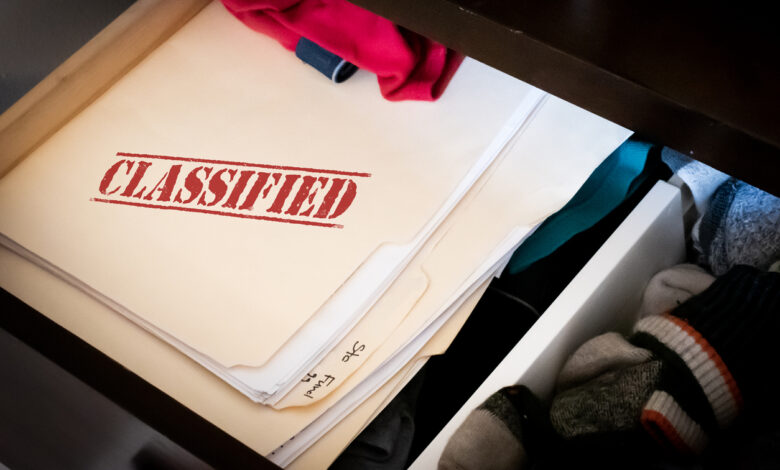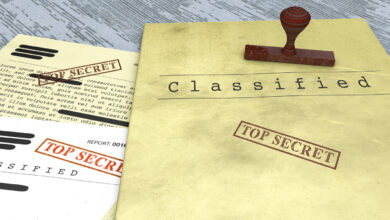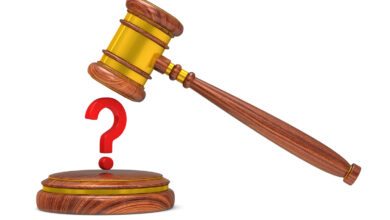Trump’s “I Mindlessly Declassified the Mar-a-Lago Documents” Defense

THE OVERHEATED PUBLIC DEBATE over whether Donald Trump really did casually declassify more than 300 classified documents on his way out of the White House—a debate given new life last week with the report of an audio recording in which Trump’s own words seem to undermine his declassification defense—is a small tempest in a large teapot.
It doesn’t mean nothing, but it doesn’t mean much.
In fact, given the manner in which Trump claims to have declassified the documents, merely by having them loaded onto a moving truck, his declassification “defense” is no defense at all. It is the opposite. If true, it won’t shield him from criminal accountability. But it reveals, yet again, his profound irresponsibility.
Let’s look at two questions: (1) Did he, in fact, declassify the documents? And (2) so what?
Question 1: Did Trump declassify the Mar-a-Lago Documents?
Short Answer: Probably not.
There’s no clear answer to the question of whether Trump did, in fact, declassify the more than 300 documents he took to Mar-a-Lago that contained classification markings, including the highest level of secrecy. But based on the information that has already been made public, the better view is that he didn’t.
Start with the question of whether he had the authority to do so without going through any kind of process and without any kind of documentation.
It is widely accepted, usually without argument, that a president has the authority to classify and declassify documents. That power is often compared to presidential pardon power, but that’s a highly misleading analogy.
While the pardon power is explicitly laid out in the Constitution (Article II, section 2, clause 1: “The President . . . shall have Power to grant Reprieves and Pardons for Offences against the United States, except in Cases of impeachment”), the Constitution says absolutely nothing about classification and declassification of information. Rather than an explicit constitutional grant of power, a president’s power to classify and declassify documents and information is generally understood to be implicit in the Constitution’s designation of the president in that same clause as “Commander in Chief” of the Army and Navy of the United States.
The legal basis for the classification system has been established not by anything in the Constitution, but by a series of executive orders culminating in the most recent, Executive Order 13526, issued by President Obama in 2009. That order sets out comprehensive guidelines governing who has classification authority, the standards for classification, levels of classification, identification and markings, prohibitions and limitations, and declassification.
Suffice it to say that Trump’s claim that he declassified hundreds of secret and top-secret documents simply by moving them from one location to another utterly fails to comply with Executive Order 13526. But that executive order isn’t a criminal statute; furthermore, since it is a presidential order, Trump could have arguably rescinded or amended it by his own actions during his presidency.
So Trump’s failure to follow the guidelines set out in Obama’s executive order, by itself, pretty clearly doesn’t answer the question of whether he did, in fact, declassify the Mar-a-Lago documents.
But the failure to employ any process (other than physically moving the documents from one place to another) probably does answer the question: It is hard to imagine any serious court decision recognizing the legitimacy and effectiveness of a purportedly casual, indiscriminate declassification of documents based entirely on their location, not their content, and without notice, inside or outside the government, to the agencies and individuals charged with the safekeeping of our nation’s secrets.
Trump almost certainly didn’t even know which documents were included in the boxes that he supposedly “declassified” by moving them to Mar-a-Lago, at least not all of them. The aides who worked with Trump in his move from the White House to Mar-a-Lago reportedly aren’t sure how the more than 300 classified documents ended up there. It appears to have been a mix of documents specifically selected by Trump himself and others packed by staffers.
Either way, Trump’s claim of declassification is missing the one quintessential element that might render that claim meaningful or substantive: any consideration of the content of the classified information.
The whole point of the classification system is to safeguard sensitive government secrets. A “process” completely untethered from the content of the information purportedly being declassified but based instead exclusively on the movement of boxes of documents from one location to another isn’t a declassification process at all. It cannot be reasonably grounded in a president’s powers as commander in chief.
To the contrary, the kind of casual, indiscriminate declassification that Trump claims to have executed would be a shocking dereliction of duty, possibly even a criminal act. Under Trump’s theory, if some aide had cluelessly thrown the nuclear codes into a box headed for Mar-a-Lago, they too would have been declassified when the box they were in was tossed into a southbound U-Haul.
Casually declassifying documents that contain our nation’s most sensitive security information, without giving even a thought to the harm that the exposure of that information could cause to our country and our allies, arguably gives aid and comfort to our enemies. If the facts are sufficiently egregious, that could be treason, a crime punishable by death.
Moreover, it’s difficult to see how a purported declassification of documents could be meaningful if none of the classification markings are removed from the documents and none of the people charged with safeguarding secret government information know that they have been declassified. In that case, what would “declassification” even mean?
In the immortal words of Dr. Strangelove, “the whole point of the Doomsday Machine . . . is lost . . . if you keep it a secret.” The Doomsday Machine could only function as a deterrent if your enemies knew you had it. Likewise, the declassification of documents has no point if you keep it secret. A secret declassification of documents changes nothing. It can hardly even be described as an “act.” If the documents continue to bear classification markings and nobody within the government knows that they have purportedly been declassified, what would declassification even mean? Nothing.
It is difficult to see how a court could give any credence to Trump’s claim that he declassified the Mar-a-Lago documents simply by moving them from one location to another, without any analysis of the potential damage to national security, and without any notification to the agencies and people charged with safeguarding government secrets. None of that random, indiscriminate conduct would fall within a reasonable interpretation of the execution of a president’s power as commander and chief of the military.
Question 2: Would it matter if Trump did, in fact, declassify the Mar-a-Lago documents?
Short Answer: Yes, but not much.
As a strict matter of black-letter law, Trump’s potential criminal liability won’t stand or fall primarily on a determination of the legitimacy of his purported declassification of the Mar-a-Lago documents. But that doesn’t mean that such a determination would be meaningless.
The search warrant executed at Mar-a-Lago last August cited three offenses of the U.S. criminal code, none of which requires a determination on whether or not the information in question was classified. 18 U.S.C. § 793 (gathering, transmitting, or losing defense information) makes no mention of classified information, protecting instead information relating to or connected with the “national defense.” 18 U.S.C. § 2071 (concealment, removal, or mutilation of government records) says nothing at all about the classification, security, or defense status of the underlying information. And 18 U.S.C. § 1519 (destruction, alteration, or falsification of records) is a wide-ranging obstruction statute that is equally silent on classification status.
Also, keep in mind that any charges relating to obstruction of or noncompliance with the Department of Justice subpoena served on Trump in May 2022 would not rise or fall on the issue of whether the documents Trump was required to produce had been declassified. The subpoena didn’t require Trump to produce “classified” documents. It required him to produce documents “bearing classification markings.” Big difference. Trump can argue until he’s blue in the face that he “declassified” everything, but he can’t argue with the fact that he failed to produce dozens of documents “bearing classification markings.”
The classification status of the documents Trump took to Mar-a-Lago would, however, be determinative if Trump were charged with a violation of 18 U.S.C. § 798 (disclosure of classified information). That statute explicitly prohibits the disclosure of “classified information.” Given the fact that the Mar-a-Lago search warrant didn’t cite 18 U.S.C. § 798, though, and the probable reluctance on the part of the DOJ to gum up the works with the whole purported declassification kerfuffle, it seems unlikely that Trump will be charged under that statute.
But the fact that the three statutes cited by the DOJ in the search warrant don’t require that the information in question be “classified” doesn’t mean that it doesn’t matter.
The classification status of information relating to the “national defense” under 18 U.S.C. § 793, for example, might not be determinative, but it could be significant to a jury at a criminal trial. A prosecutor would certainly point to the fact that the information had the highest level of government classification in order to bolster a claim that the information was vital to the national defense. By the same token, if the information weren’t classified, a defense attorney would surely argue that it couldn’t have been very important to the national defense. Neither argument would be a sure winner, but it could matter.
In this case, however, the manner in which Trump purportedly declassified the documents, not just a binary determination of whether or not he did so, would again come into play. A declassification that went through a formal, deliberative process to assess whether release of the information could harm the national security would undoubtedly weigh heavily on a jury’s determination of whether “national defense” information had been criminally gathered or transmitted. By contrast, a casual “declassification” based entirely on the movement of a box of documents, untethered to their content, would likely have little impact on a judge or jury.
AT THE END OF THE DAY, the public debate over whether Trump actually declassified the documents largely misses the point. Any serious look at Trump’s declassification story leads to the conclusion that it’s hogwash, but even if it were given credit, it wouldn’t have much of an impact on his potential criminal liability.
What is truly significant here is the fact that Trump claims to have declassified some of our nation’s most closely held national security secrets with the wave of a hand, without the least thought to their content or the national security ramifications of their disclosure. That claim will brand Trump, yet again, as the most self-serving, reckless president in American history.




